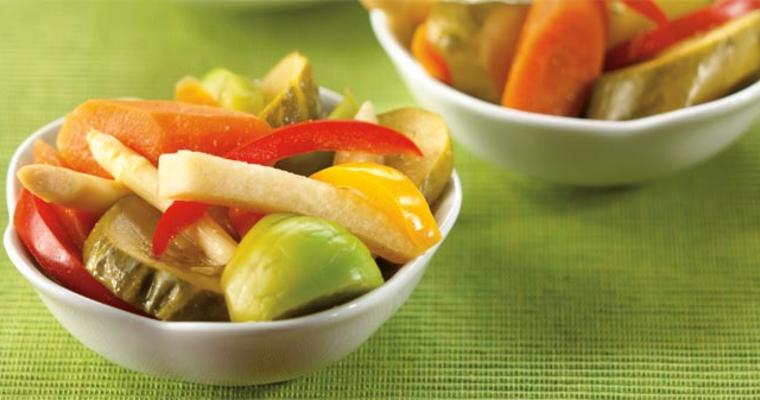We are in the business of flavor. With all you hear about what a restaurant has to offer—sustainable cooking, live music, exciting design, etc.—only one thing really matters: Is the food good?
Flavor is a journey, not a destination
You can’t just write your restaurant menu and consider your work done. Menus need to evolve over time, to become more complex in some areas and streamlined in others. They need to draw inspiration from new cuisines and stay on top of emerging trends. And, because sophisticated diners seek out new discoveries of flavor, finding ways to deliver them is critical.
Building flavor layer by layer is a core component of fine cooking. Just as the best stocks and sauces layer in flavors from the beginning, so do the best finished dishes. Start with a base of protein or vegetables and create flavor using techniques such as brining or marinating. Next, choose the cooking method that will best enhance those flavors. Then top off everything with a big flavorful finish.
Salt-and-vinegar solutions
Two basic ingredients—salt and vinegar—are almost magical in their ability to transform and preserve food. Pickling, brining, and fermenting—three of today’s most popular ways to add flavor—would be impossible without them.
Pickling, as a flavor trend, is huge right now. Not canned pickles. I’m talking about fresh refrigerator pickles that take hardly more than 20 minutes to make and keep well—up to a month if you can make enough to last that long. All it takes is hot brine and a tub of cleaned, trimmed vegetables or fruit to have an assortment of unique pickles on hand. Menu them as a sharing-plate item, or serve as a garnish to rich dishes where their bright, tangy flavor can help cut the fat and provide balance.
Brining is most effective when you’re working with “white” meats—pork and poultry. As with marinades, brining adds flavor and moisture, and can be subtly infused with spices and herbs. Peppercorns, allspice, coriander, bay leaves, and cinnamon, as well as apple juice or cider, are all traditionally used in brines. Turkey breast or pork chops brined overnight are incomparable for flavor and juiciness.
Few things produce a wallop of flavor as bold and intensely savory as fermentation. And now, one of the best products of flavorful fermentation—kimchee, the Korean condiment of fermented cabbage with chili paste and fish sauce—is catching on as an ingredient in sandwiches, as a garnish, or mixed into sauces.
Flavor-enhancing cooking methods
One excellent way to ramp up flavor profiles is to use a variety of cooking methods to produce dramatic effects.
Pan-roasting brings out a noticeably greater depth of flavor to food than steaming or boiling.
Grilling enhances flavor through caramelization and the infusion of smoke into the finished product—and not just meat, either. Both wood and charcoal grills provide ample opportunities for preparing a wide range of items: vegetables, breads, pizzas. Using a screen, you can even grill small items such as cauliflower buds or fresh peas, or fruit, including blackberries and cherries.
Deep-frying produces wonderfully caramelized, luscious vegetables—especially hearty Brussels sprouts or cauliflower—that become shareable snacks to pair with dipping sauces or sides to serve with entrées. Deep-fry unbreaded, trimmed portions for about a minute for vegetables that are deeply caramelized and incredibly flavorful. This luxurious cooking method also produces items diners cannot easily replicate at home. The opportunity for diners to treat themselves or try something new is crucial. Moreover, the distinctive items you can produce this way will make your operation stand out.
Where there’s smoke, there’s flavor
The smoked-food trend continues to grow thanks to the deep, complex flavors that smoking imparts. You can smoke food via a wood-fired or electric smoker, stovetop smoking, or a literal “smoking gun”.
Self-contained wood-fired or electric smokers are the best option if you’re smoking a lot of food. They also can be operated outside—a real plus for small kitchens.
Stovetop smoking can be accomplished with equipment you likely have on hand, and it’s effective for smoking small quantities. Add a layer of wood chips to the bottom of a 4-inch-deep stainless-steel hotel pan and place a screen or perforated hotel pan on top to hold the food. Cover everything with foil or a lid and place over the burners (and under the hood system to draw the smoke away).
A smoking gun—a handheld, electric unit that uses sawdust plugs with a small internal fan—is a great tool for smoking prepared sauces or finishing a dish. Just put the food into a plastic bag or container and use the gun to fill the space with smoke.
Condiment innovations
Tinkering with commercially produced condiments is certainly not new. Step up the plus-one approach by incorporating new flavors—kimchee, smoke, housemade pickles, etc.—to offer exciting new combinations custom-tailored to your restaurant menu. Add tart and tangy fruit to mustard, temper ketchup’s sweetness with fiery chili or savory anchovies, or riff on aïoli by adding Sriracha or salsa.
A big finish
A flavorful finishing touch is something diners notice immediately, and it can take a dish from good to great with little effort. Aromatic infused oils and compound butters are perfect for this. Oils and butter readily take on the flavor of herbs, spices, and citrus, many of which are fat-soluble.
Infused oils can be prepared quickly with a 180°F infusion for 20 to 30 minutes, and finished by straining the oil through cheesecloth. Dried and/or smoked Pasilla chilies, black (fermented) garlic, fire-roasted/grilled lemon produce outstanding grapeseed- or olive-oil infusions.
Compound butters can be created with everything from chili paste and house spice blends to sun- or oven-dried tomatoes, roasted garlic, and even smoke. Here’s where that smoking gun comes in handy.
Don’t forget to top off everything with flavorful garnishes that add texture and eye appeal—say, crispy fried onions or chopped, roasted nuts. The possibilities are virtually limitless.
Finding opportunities to add flavor from start to finish is our business.











